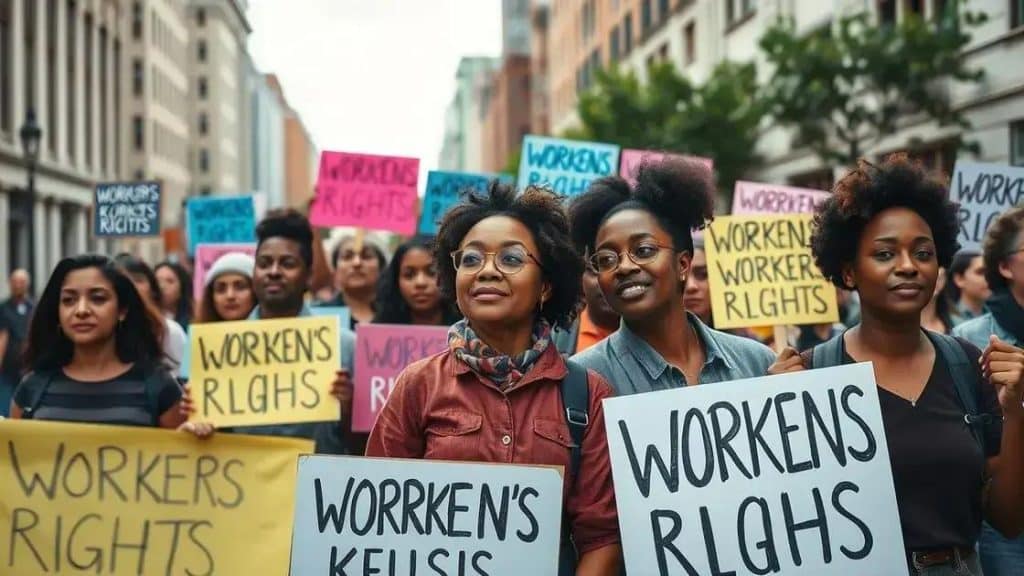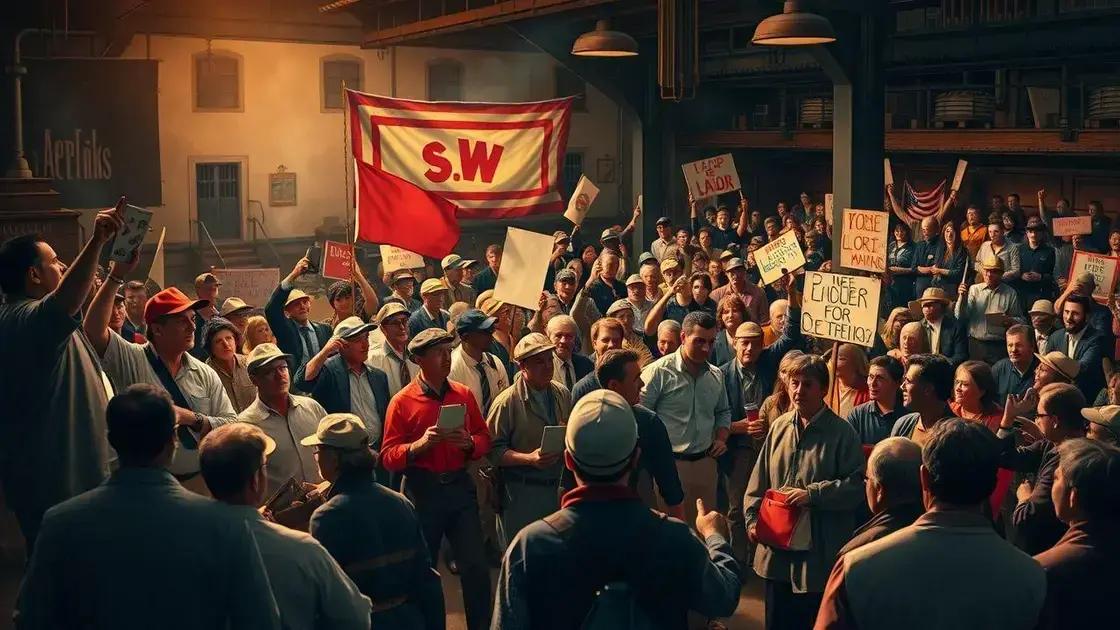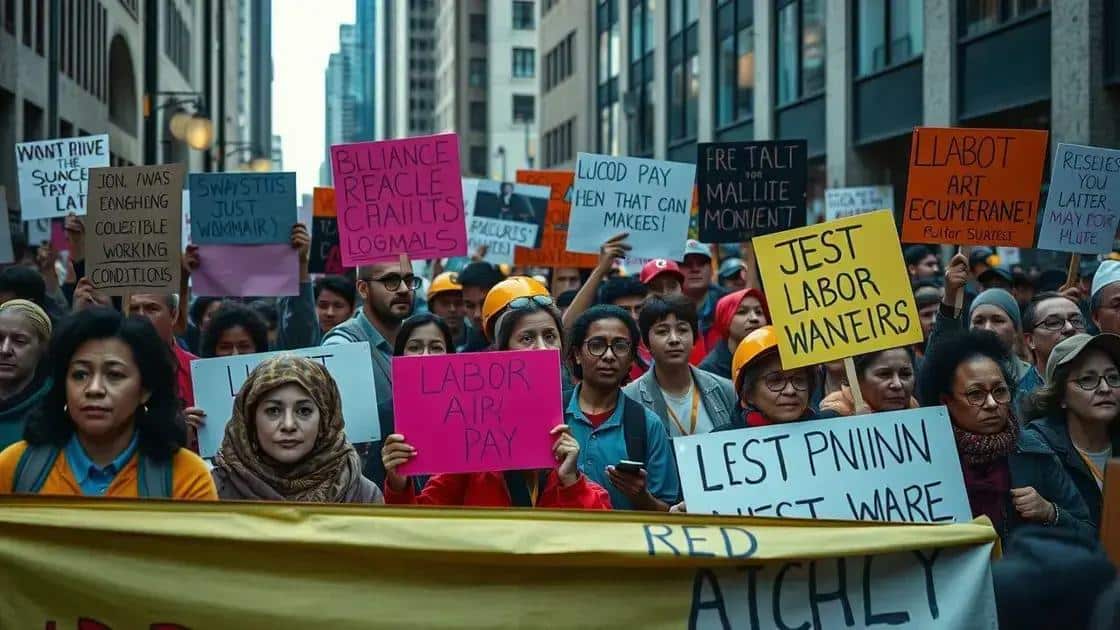Central labor movement stories that changed history

Contemporary labor movements address ongoing challenges such as fair wages, job security, and workplace conditions, playing a crucial role in advocating for workers’ rights and fostering equity in the workforce.
Central labor movement stories reveal the powerful narratives that shaped workers’ rights throughout history. Have you ever wondered how these movements influence our daily lives? Let’s dive into these compelling tales.
Key figures in the labor movement
The labor movement has been shaped by numerous influential figures. Their dedication and actions have paved the way for crucial changes in workers’ rights. Understanding these key figures gives us insight into the power of solidarity and activism in the face of adversity.
Influential Leaders
Mary Harris Jones, also known as Mother Jones, was a prominent organizer who fought tirelessly for miners’ rights. Her passionate speeches rallied many to the labor cause. Samuel Gompers founded the American Federation of Labor and pushed for better working conditions, wages, and hours.
Revolutionary Activists
Figures like Big Bill Haywood, leader of the Industrial Workers of the World, advocated for direct action and worker control of industries. These activists inspired waves of organizing that resonated across various sectors. Their efforts highlighted the devastating conditions many workers faced.
- Mary Harris Jones championed labor rights and child labor laws.
- Samuel Gompers promoted the 8-hour workday and fair wages.
- Big Bill Haywood empowered workers across industries to unite.
- A. Philip Randolph organized the Brotherhood of Sleeping Car Porters, fighting for Black labor rights.
Through their challenges and victories, these key figures helped to shape labor laws and social justice in significant ways. This struggle for workers’ rights emphasized the need for collective action and advocacy. Labor leaders not only fought for fair wages but also for the recognition of workers as essential contributors to society.
These brave individuals were often met with resistance, yet their resolve never wavered. Their legacy continues to inspire current and future generations to stand up for what they believe in. By understanding their stories, we honor their contributions to the present-day labor movement. Their impact is evident as we continue to strive for equity and justice in the workplace.
Milestones in labor rights history

Milestones in labor rights history have shaped the landscape of workers’ protections and rights. Understanding these key events helps shed light on the ongoing struggles many workers face today.
The Formation of Labor Unions
In the late 19th century, the formation of labor unions marked a significant turning point. Workers started to organize to demand better wages, safer working conditions, and reasonable hours. One notable example is the creation of the American Federation of Labor (AFL) in 1886, which united various craft unions.
The Eight-Hour Workday
One of the most pivotal victories came with the fight for the eight-hour workday. This movement gained traction in the 1880s and culminated in the Haymarket Affair in 1886. This struggle emphasized how essential work-life balance is for employees.
- The eight-hour workday became a national demand.
- Labor Day was established in 1894 to celebrate these achievements.
- Advocates highlighted the need for breaks and safety in the workplace.
- This movement paved the way for various labor standards we recognize today.
Another important milestone occurred during the Great Depression. During this time, the National Labor Relations Act was passed in 1935. This act protected workers’ rights to organize and engage in collective bargaining. It was crucial in legitimizing unions and ensuring employee representation.
The impact of these milestones is profound and lasting. They serve as a reminder of the power of collective action and advocacy. As movements evolved, more rights were won, including minimum wage laws and workplace safety regulations. This ongoing journey illustrates how each generation builds on the efforts of those who came before.
The struggles and triumphs within labor rights history reveal the importance of ongoing vigilance and activism. By understanding these key milestones, we can pave the way for a fairer and more equitable work environment for all.
Impact of labor movements on society
The impact of labor movements on society is profound. These movements have historically shaped laws and cultural norms regarding work, advocating for rights that many take for granted today.
Social Changes
Labor movements have spurred significant social changes. For example, the push for better wages and working conditions has led to stronger laws protecting workers. Initiatives from these movements have created a safer work environment and elevated standards of living for countless families.
Legislation and Rights
As labor movements grew, they influenced key legislation like the Fair Labor Standards Act (FLSA), which established minimum wage and overtime pay. Such laws have been essential in supporting the rights of workers across various industries.
- Labor movements raised awareness about the importance of fair pay.
- They fought against child labor, leading to reforms that protect children.
- Movements created essential workplace safety standards.
- Advocacy for paid sick leave and family leave continues to evolve from these efforts.
This advocacy has helped create a culture where workers are more empowered to speak up about their rights. Labor organizations provide support and resources, making it easier for individuals to join forces and demand better treatment in their workplaces.
The effects of labor movements extend beyond workplaces, influencing public opinion and media portrayals of workers’ rights. They have fostered a greater understanding of economic disparities and social justice. This shift in perspective often pushes industries to adopt more ethical practices.
Despite the achievements, challenges remain. Current movements continue to address inequalities and push for changes in legislation that reflect the needs of modern workers. As society evolves, so does the impact of labor movements, reminding everyone that collective action remains vital.
Contemporary labor issues and movements

Contemporary labor issues and movements are shaping the future of work in today’s society. As the workforce evolves, new challenges arise, and movements adapt to address these concerns.
Current Challenges
Many workers still face unfair wages and poor working conditions. The push for a higher minimum wage continues in various states. Gig economy workers often lack protections and benefits, raising concerns about job security and rights.
Union Organizing
Strong unions are vital in advocating for workers’ rights. Many contemporary movements focus on unionizing workplaces that traditionally resisted such efforts. Successful campaigns illustrate the power of collective bargaining and solidarity among workers.
- Amazon employees have organized strikes for better pay and conditions.
- Starbucks workers are pushing for union representation in multiple locations.
- Healthcare workers are advocating for safer working environments.
- Fast food workers demand higher wages through organized protests.
Moreover, the fight for workplace diversity and equity remains critical. Movements are increasingly addressing issues like racial and gender discrimination, ensuring fair treatment for all workers. Activism also includes a focus on mental health support in work environments.
These labor movements inspire a new generation to take action. With social media, workers can connect and amplify their voices quickly. Movements like #MeToo and Black Lives Matter have influenced labor issues, emphasizing the intersection of rights across various sectors. The collaboration among diverse groups in the workforce creates a larger platform for change.
As we look to the future, contemporary labor issues will continue to evolve. Workers pushing for better conditions and rights will remain essential in influencing positive changes. It is imperative to stay informed and engaged in these movements to ensure that all workers are treated fairly and equitably.
FAQ – Frequently Asked Questions about Labor Movements
What are the primary goals of contemporary labor movements?
The primary goals include advocating for fair wages, improving working conditions, and ensuring job security for all workers.
How do labor movements impact workers’ rights?
Labor movements push for legislation that protects workers’ rights, helping to establish minimum wage laws, workplace safety standards, and collective bargaining rights.
What role do unions play in labor movements?
Unions organize workers to collectively bargain with employers, which strengthens their negotiating power and helps secure better pay and conditions.
Why is it important for young workers to engage in labor movements?
Engaging in labor movements allows young workers to advocate for their rights and contribute to shaping fairer workplaces for future generations.





